
 By Herbie J Pilato
By Herbie J Pilato
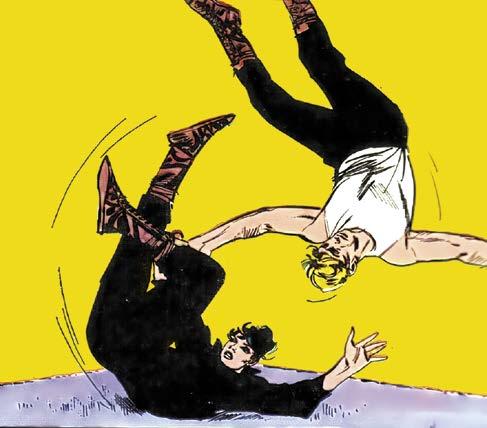
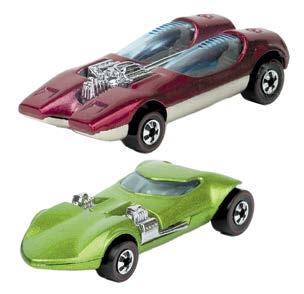
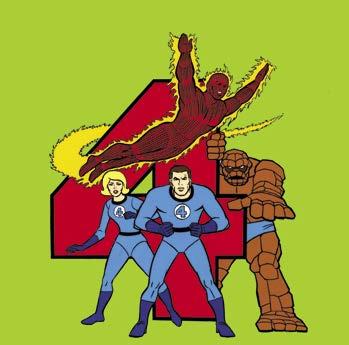
July 2024 No. 33 $10.95 FANTASTIC FOUR on Saturday mornings You’ll flip over MODESTY BLAISE HOT WHEELS: TheEarlyYears You get a big delight in every bite! THE HEYDAY OF HOSTESS Lee Majors/Lindsay Wagner photograph courtesy of the Classic TV Preservation Society. Spider-Man and Fantastic Four © Marvel. Modesty Blaise © Modesty Blaise Ltd. Hot Wheels © Mattel. Hostess Twinkies © Hostess Brands, LLC. All Rights Reserved. Featuring Andy Mangels • Will Murray • Scott Saavedra • Scott Shaw! • Mark Voger • Michael Eury TV Westerns • Movie Icons vs. Axis Powers • San Diego Chicken & more! LINDSAY WAGNER & LEE MAJORS The Bionic Duo!
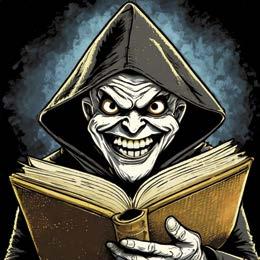
“Greetings, creep culturists! For my debut issue, I, the CRYPTOLOGIST (with the help of FROM THE TOMB editor PETER NORMANTON), have exhumed the worst Horror Comics excesses of the 1950s, Killer “B” movies to die for, and the creepiest, kookiest toys that crossed your boney little fingers as a child! But wait... do you dare enter the House of Usher, or choose sides in the skirmish between the Addams Family and The Munsters?! Can you stand to gaze at Warren magazine frontispieces by this issue’s cover artist BERNIE WRIGHTSON, or spend some Hammer Time with that studio’s most frightening films? And if Atlas pre-Code covers or terrifying science-fiction are more than you can take, stay away! All this, and more, is lurching toward you in TwoMorrows Publishing’s latest, and most decrepit, magazine—just for retro horror fans, and featuring my henchmen WILL MURRAY, MARK VOGER, BARRY FORSHAW, TIM LEESE, PETE VON SHOLLY, and STEVE and MICHAEL KRONENBERG!”
(84-page FULL-COLOR magazine) $10.95 (Digital Edition) $4.99
#1 ships October 2024!
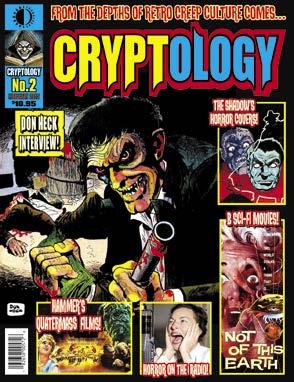
CRYPTOLOGY #2
The Cryptologist and his ghastly little band have cooked up more grisly morsels, including: ROGER HILL’s conversation with our diabolical cover artist DON HECK, severed hand films, pre-Code comic book terrors, the otherworldly horrors of Hammer’s Quatermass, another Killer “B” movie classic, plus spooky old radio shows, and the horror-inspired covers of the Shadow’s own comic book. Start the ghoul-year with retro-horror done right by FORSHAW, the KRONENBERGS, LEESE, RICHARD HAND, VON SHOLLY, and editor PETER NORMANTON
(84-page FULL-COLOR magazine) $10.95
(Digital Edition) $4.99 • Ships January 2025
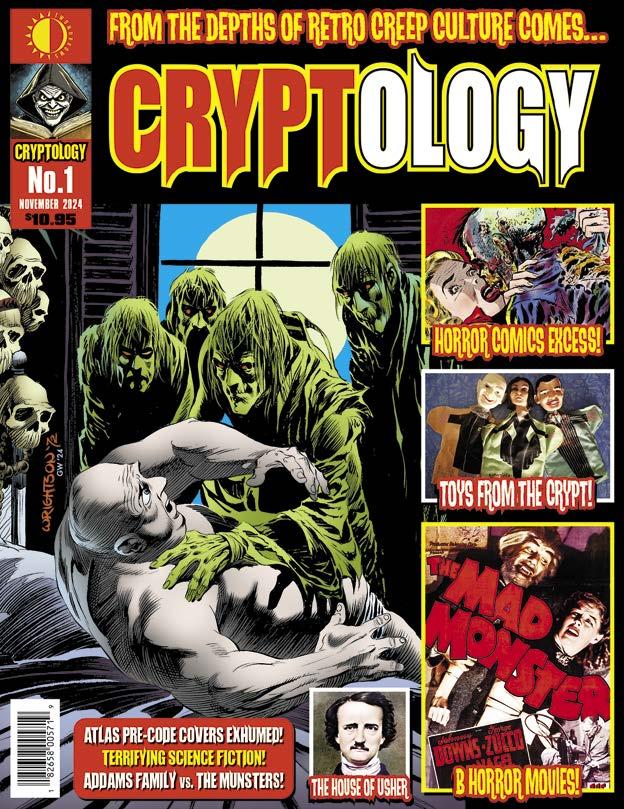

CRYPTOLOGY #3
This third wretched issue inflicts the dread of MARS ATTACKS upon you—the banned cards, the model kits, the despicable comics, and a few words from the film’s deranged storyboard artist PETE VON SHOLLY! The chilling poster art of REYNOLD BROWN gets brought up from the Cryptologist’s vault, along with a host of terrifying puppets from film, and more comic books they’d prefer you forget! Plus, more Hammer Time, JUSTIN MARRIOT on obscure ’70s fear-filled paperbacks, another Killer “B” film, and more to satiate your sinister side!
(84-page FULL-COLOR magazine) $10.95
(Digital Edition) $4.99 • Ships April 2025
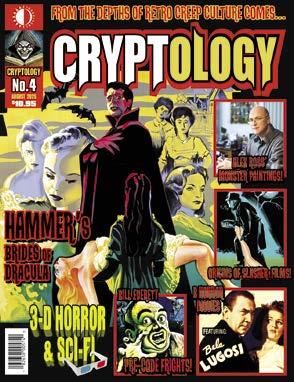
CRYPTOLOGY #4
Our fourth putrid tome treats you to ALEX ROSS’ gory lowdown on his Universal Monsters paintings! Hammer Time brings you face-to-face with the “Brides of Dracula”, and the Cryptologist resurrects 3-D horror movies and comics of the 1950s! Learn the origins of slasher films, and chill to the pre-Code artwork of Atlas’ BILL EVERETT and ACG’s 3-D maestro HARRY LAZARUS. Plus, another Killer “B” movie and more awaits retro horror fans, by NORMANTON, the KRONENBERGS, LEESE, VOGER, and VON SHOLLY!
Ships
(84-page FULL-COLOR magazine) $10.95 (Digital Edition) $4.99 •
July 2025
All characters and properties TM & © their respective owners.
TwoMorrows. The Future of Comics History. TwoMorrows Publishing 10407 Bedfordtown Drive Raleigh, NC 27614 USA 919-449-0344 E-mail: store@twomorrows.com Order at twomorrows.com Horror Four-issue subscriptions: $53 in the US $78 International $19 Digital Only
Satiate Your Sinister Side!

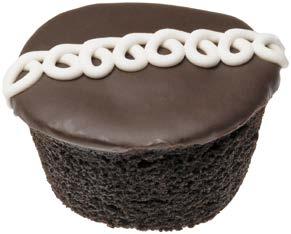



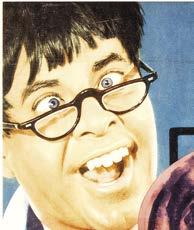
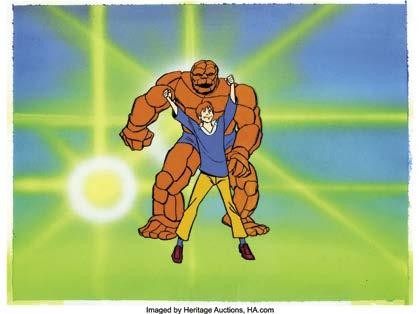
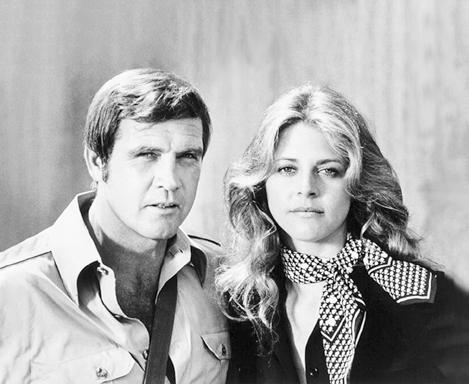

3 Retro Television The Six Million Dollar Man and The Bionic Woman –Fiftieth Anniversary 15 Scott Saavedra’s Secret Sanctum The Heyday of Hostess 25 Voger’s Vault of Vintage Varieties Movie Icons vs. Axis Powers 33 Andy Mangels’ Retro Saturday Morning The Fantastic Four and The Thing 47 Will Murray’s 20th Century Panopticon TV Westerns Ride into the Sunset 58 Retro Toys Hot Wheels: The Early Years 63 Retro Comic Strips Modesty Blaise 72 Oddball World of Scott Shaw! The San Diego Chicken 2 Retrotorial 22 Too Much TV Quiz Sign-off phrases 32 Celebrity Crushes Jerry Lewis 79 RetroFanmail 80 ReJECTED ™ issue 33, June 2024 (ISSN 2576-7224) is published bi-monthly by TwoMorrows Publishing, 10407 Bedfordtown Drive, Raleigh, NC 27614, USA. Phone: (919) 449POSTMASTER: Send address changes to RetroFan, c/o TwoMorrows, 10407 Bedfordtown Drive, Raleigh, NC 27614. Michael Eury, Editor-in-Chief. John Morrow, Publisher. Editorial Office: RetroFan, c/o Michael Eury, Editor-in-Chief, 112 Fairmount Way, New Bern, NC 28562. Email: euryman@gmail.com. Six-issue subscriptions: $73 Economy US, $111 International, $29 Digital Only. Please send subscription orders and funds to TwoMorrows, NOT to the editorial office. Lee Majors and Lindsay Wagner photograph credit: Classic TV Preservation Society. The Six Million Dollar Man and The Bionic Woman © NBCUniversal. Hostess brands © J.M. Smucker Company. Hot Wheels® © Mattel. Hot Wheels cover photograph credit: Mike Pigott. Spider-Man and the Fantastic Four © Marvel. Modesty Blaise © Modesty Blaise Ltd. All Rights Reserved. All characters are © their respective companies. All material © their creators unless otherwise noted. All editorial matter © 2024 Michael Eury and TwoMorrows. Printed in China. FIRST PRINTING. June 2024 Issue # 33 Departments Columns and Special Features The Crazy Cool Culture We Grew Up With 15 25 63 47 32 58 3 33
Happy 50th Bionic Anniversary to Steve Austin and Jaime Sommers

A Golden Cybernetic Celebration of The Six Million Dollar Man and The Bionic Woman
The Vietnam War had ended, as had the Korean War, World War II, and World War I long before. Man had not yet conquered space, but he at least landed on the Moon. The Women’s Liberation Movement was in full swing decades after those like Susan B. Anthony laid the groundwork for female empowerment. The trials and tribulations of the Sixties were replaced by the slightly more tranquil, but still tumultuous Seventies. The time was prime for a new set of super-heroes, and what better place to introduce them than prime-time television?
Astronaut Col. Steve Austin, as played by Lee Majors, became The Six Million Dollar Man the character and the sci-fi TV series of the same name which originally aired on ABC from 1973 to 1978. Former tennis champion Jaime Sommers, as portrayed by Lindsay Wagner, became The Bionic Woman the character and the spin-off show of the same name that was first screened on ABC and then NBC from 1975 to 1978. In each case, became is the operative word,
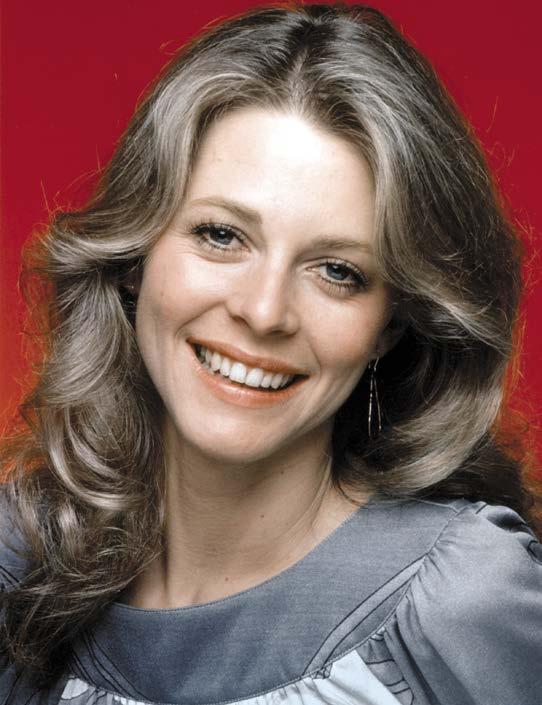 BY HERBIE J PILATO
BY HERBIE J PILATO
while operative itself is an applicable term. Steve and Jaime, born human, became, as in transformed into, operatives, as in special government agents
Steve and Jaime’s core employment force? The OSO, the Office of Strategic Operations, later known as the OSI, the Office of Strategic Investigations. In the original 90-minute Six Million Dollar pilot film, which premiered March 7, 1973, Darren McGavin gave voice to Oliver Spencer, the OSO’s supervising official. When both The Six Million Dollar Man [SM] and The Bionic Woman [BW ] went to series, Richard Anderson as Oscar Goldman became Steve and Jaime’s ultimate government go-to-guy.
(ABOVE) Fifty years ago, Lee Majors first electrified audiences as Col. Steve Austin, the Six Million Dollar Man… and before long he was joined by Lindsay Wagner as the Bionic Woman! The Six Million Dollar Man and The Bionic Woman © NBCUniversal. Photos courtesy of the Classic TV Preservation Society (CTVPS).
RETROFAN June 2024 3
The Bionic
[Editor’s note: This material is edited and expanded material from Herbie J Pilato’s “Special Commemorative Edition” of The Bionic Book: The Six Million Dollar Man and
Woman Reconstructed.]
RETRO TELEVISION
With his calm, cool, and tactical expertise, Oscar oversees and assigns the adventures of Steve Austin and Jaime Sommers. But Oscar is not Obi-Wan Kenobi, Yoda, nor Jor-El, as Col. Austin and Ms. Sommers are not Superman or Wonder Woman. Like the rest of us from birth, Steve and Jaime are not endowed with the naturally born anatomical advantages of a Captain Marvel or Supergirl Unlike the rest of us, their acquired abilities, supplied by Dr. Rudy Wells (played by Martin Balsam in the SM pilot; Alan Oppenheimer and Martin E. Brooks, respectively, in the subsequent SM and BW shows), are superior to those they were given, biologically though not as flexible.
Steve and Jaime are the equal sums of diverse parts, literally. Their legs are bionic, as are their right arms; he has super-sight in his left eye; she, super-hearing in her right ear. Composed of a kind of accelerated science and human nature, they are still flawed but improved. Perfect for each other, but imperfect, recognizable characters; separated through the years, yet finally ending up together once and forever (per a series of later-day TV reunion movies). Neither run-of-the-mill super-heroes, nor comic book caricatures, and not just partially synthetic, they are fully authentic. With accessible and likable personalities, and a residue of angst due to their bionic conversion, Steve Austin and Jaime Sommers are above-average individuals before and after their metamorphosis: heroes first; super, second; human always. In various incarnations over the decades, by way of multiple media platforms (syndicated reruns, comic books, video release, DVD, streaming, and Blu-ray), this atomic-powered, romantically entangled dynamic twosome continues to save the day.
Nothing can stop the popularity of The Six Million Dollar Man and The Bionic Woman, just as any force of evil never prevails against the very the characters of Steve Austin and Jaime Sommers. Even in the worst of circumstances, Steve and Jaime are victorious, despite a formidable profusion of villains.
Kildozer, based on the 1944 novel of the same name); Alex, the 2001: A Space Odyssey/HAL-like supercomputer with a yet another A.I. mind of its own created by Dr. Elijah Cooper (played film legend
Lew Ayres, the big screen’s second Dr. Kildare); Monte Markham as Barney Miller-later-Hiller, the Seven Million Dollar Man, a rouge bionic man gone wild.
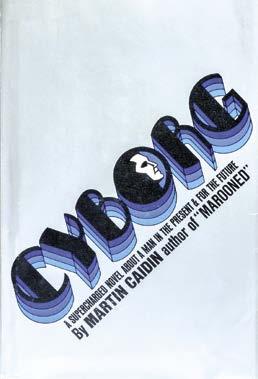
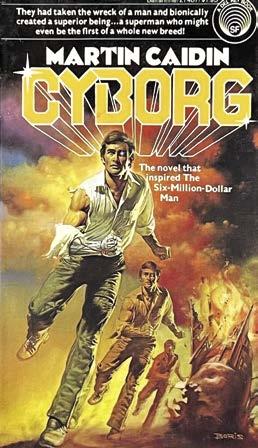
For starters, those being the detonated android replica of Major Frederick Sloan, Steve’s friend and colleague (played by John Saxon, movie martial artist, and star of Genesis II, the failed but noble Gene Roddenberry pilot film); the diabolical Dr. Dolenz (Henry Jones from the classic 1956 Bad Seed feature film, and TV’s Phyllis), who created the fake Sloan; the Fembot Army, created by the equally dastardly Dr. Franklin (actor/scholar John Houseman, who starred with Lindsay Wagner in 1973’s The Paper Chase); the cybernetic alien Bigfoot/Sasquatch (a role shared by Ted Cassidy of TV’s The Addams Family and Andre the Giant); the Bigfoot-controlling humanoid alien Nedlick (a return/ new performance by John Saxon), the Soviet Death Probe (a mindof-its-own-machine reminiscent of vehicles presented in Steven Spielberg’s iconic 1971 TV-movie, Duel, and the 1974 TV-movie,
(TOP) First edition of Martin Caidin’s novel, Cyborg. © Martin Caidin. (BOTTOM) Original painted artwork by Boris Vallejo for Ballantine Books’ 1978 paperback reprinting of Cyborg. Courtesy of Heritage.
Those on the Bionic good side to help Steve and Jaime along the way include Steve’s mother
Helen (who twice played Charlton Heston’s big-screen mother, first in The Ten Commandments and then Ben-Hur); Steve’s adopted father Jim Elgin (Ford Rainey); Andy Sheffield, the Bionic Boy (Vince Van Patten, son of Dick Van Patten, the TV father on Eight is Enough, both of whom were good friends with Lee Majors and then-wife Farrah Charlie’s Angels Fawcett, who made three guest-appearances on SM); Max, the Bionic Dog, which Jaime adopts in the third season of BW; Peggy Callahan, Oscar Goldman’s sharp, charming, and loyal executive assistant (who, however, in one episode, is Fembot-cloned to kill him); trusted OSI agent Russ (Sam Chew, Jr.), Dr. Michael Marchetti (Richard Lenz) and Chris Williams (Christopher Stone, married to Dee E.T. Wallace) as two of Jaime’s post-Steve boyfriends; Darwin Jones, the spiritual-biological master portrayed by the acclaimed actor Granville Van Dusen, among others.
An impressive galaxy of guest-stars in various roles, good and evil, added an additional sheen to the Bionic shows. On SM, those include David McCallum (The Man from U.N.C.L.E, and later The Invisible Man TV series produced by SM ’s Harve Bennett), Don Porter (Gidget), William Shatner and George Takei (both from Star Trek: The Original Series), Robert F. Simon, David White, and Maurice Evans (all from Bewitched ); Elizabeth Ashley, France Nuyen, George Montgomery, the Oscar-winning, once-blacklisted Ann Revere (who played Elizabeth Taylor’s mother in 1944’s National Velvet), Lara Parker (Dark Shadows), Joan Darling (no relation to Jennifer, but the future director and former co-star to Lee Majors on Owen Marshall, Counselor at Law), Sonny Bono, George Foreman, classic movie legend Donald O’Connor (Singing in the Rain), Tippi Hedren (Alfred Hitchcock’s favorite actress, and Lindsay Wagner’s favorite aunt), Andy Griffith, Forrest Tucker, Evel Knievel, and countless more.
The elite power production team included producer/writers Arthur Rowe, Lionel Siegel, Craig Schiller, Arthur Rowe, DC Fontana and Larry (Star Trek), Terrence McDonnell, Mark Frost, William T. Zacha, Steven de Souza, Harold Livingston, Del Reisman, the legendary Stephen Bochco (Hill Street Blues), the aforementioned Harve Bennett (who went on to save the Star Trek feature film franchise after Star Trek: The Motion Picture was initially perceived as lackluster), and Kenneth Johnson (pre-TV’s The Incredible Hulk and Alien Nation), who also directed.
RETRO TELE v I s IO n RETROFAN June 2024 4
was ghost-written by a then-unknown Steven Bochco, who went on to create and produce Hill Street Blues, L.A. Law, and the controversial hit, NYPD Blue (Emmy winners, all).
The manned space shuttle program was diminished. Col. Steve Austin, the youngest astronaut to have moonwalked, was demoted in rank to an experimental flier with the U.S. Air Force. Highly educated, Col. Austin was considered a genius by his fellow astronauts. He maintained five academic degrees in all, including a Masters in aerodynamics, astronautical engineering, and, surprisingly enough, history. Physically fit, Austin enjoyed wrestling, boxing, and fencing, while achieving a black belt in judo and Aikido. He speaks conversational Russian and fluent Spanish. Before joining the Air Force, Steve had a tour of duty with the Army in Vietnam, where he was a chopper pilot.
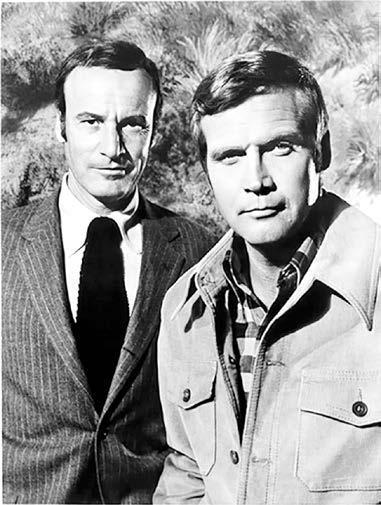
(LEFT) Lee Majors as Steve Austin and Richard Anderson as Oscar Goldman in a 1974 ABC-TV publicity photo promoting The Six Million Dollar Man. Courtesy of Heritage. (RIGHT) Majors and Lindsay Wagner in their signature roles. Courtesy of CTVPS.
In 1973, at six-foot-one and 32 years old, Austin’s trial-run aircraft, the M3F5 (the HL-10 in the series; the M2-F2 in reality) was annihilated in a horrific mishap, and Steve was nearly killed. Left a multiple amputee, his left arm, both legs and his left eye were gone (in the series, his right arm was severed). Critically injured, he was remade as The Six Million Dollar Man. Now bionic, Steve has superhuman strength in both legs, his right arm, and his left eye offers him super-sight. He can also run 60 miles an hour. Yet, he’s human.
“What happened to Steve in that crash, is what happens to pilots all the time,” professed Martin Caidin. In fact, the footage used in SM ’s opening credit sequence is that of an authentic aircraft accident.
On May 10, 1967, NASA lifting body pilot Bruce Peterson, 33, crashed his M2-F2 while attempting to land at Edwards Air Force Base [California], then commanded by Dave Edwards. Distracted by a rescue helicopter and blown off course by crosswinds, his flying machine hit the ground at 250 MPH and rolled over six times, bouncing along from wing tip to wing tip before coming to rest on its flat back, minus its canopy, main gear, and right vertical fin. The crash wreaked terrible facial injuries on the pilot, whose skull was fractured and whose torso was battered by fragmenting sections of the aircraft’s nose. Each time the vehicle rolled, a stream of high-velocity lakebed clay assaulted Peterson’s face. Apparently, if he had just had a second more, he would have landed the aircraft safely.
“About what is seen on the TV screens every week is what I remember,” said Peterson, in a 1975 Associated Press interview. “That partial footage was taken by the cockpit cameras. I blacked out about the same time the cameras stopped working. I was landing, fighting a crosswind that had sprung up, when I saw a
helicopter in my way. I tried to avoid it, and the landing gear caught in the dry lakebed and right there I thought that was it. The next thing I vaguely remember is being trapped in the vehicle upside-down.”
Though Peterson and other real-life navigators were never fortunate enough to undergo cybernetic reconstruction, the Bionic scribe set out to explore the emotional impact of their experiences, against a backboard of science fiction.
But who would Peterson’s essential TV alter ego? At first, Caidin envisioned actor Monte Markham in the role of Steve Austin. Markham, then best known for the short-lived high-concept
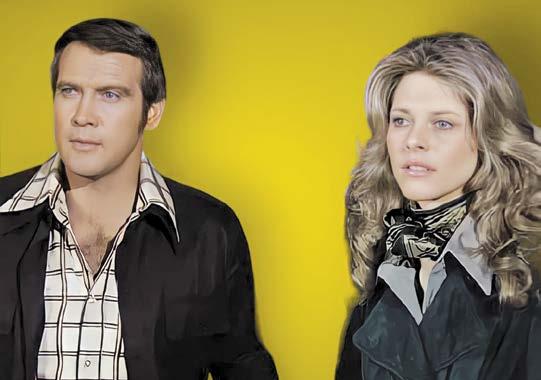
sitcom, The Second Hundred Years, had recently played Perry Mason in a failed 1974 TV reboot of the original Raymond Burr series. But according to Caidin, studio executives believed Markham’s eyes were too “steely” to play a hero.
While Markham would later surface in the Bionic Universe as the villainous Seven Million Dollar Man in two SM episodes, there was clearly only one man for the job to play Steve Austin: Lee Majors.
Already a TV staple, Majors had supporting roles in the mid-Sixties through the early Seventies in TV Westerns like The Big Valley, The Men from Shiloh, and later, the courtroom drama Owen Marshall, Counselor at Law. In Law, he played Jess Brandon, young legal sidekick to Arthur Hiller, just as James Brolin had been the young Dr. Steve Kiley associate to Robert Young’s lead on Marcus Welby, M.D. And while the Marshall and Welby shows were produced by David Victor (with Lindsay Wagner guest-starring in both, pre-Jaime Sommers), The Six Million Dollar Man presented Lee with the opportunity to shine with his first starring role.
“I’ve advanced one banana at a time,” Majors once observed. “On The Big Valley, I was fourth banana behind Barbara Stanwyck. On The Men from Shiloh, I was third banana to James Drury and Doug McClure. On Owen Marshall, I was second banana. And now, finally, I’ve made it to the top.”
Additionally, acting in Owen Marshall was not a pleasant experience for Majors. He was literally not suited to the business-like
RETRO TELE v I s IO n RETROFAN June 2024 6
BY s COTT s AAv EDRA
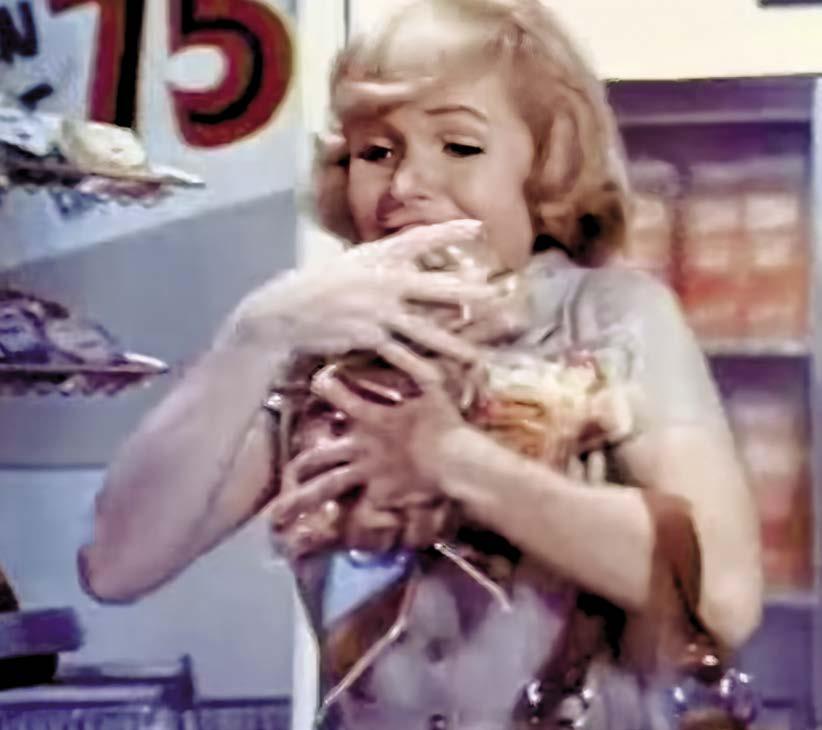
The heyday of Hostess® is when you were a kid. A time when you were most open to new taste treat sensations and didn’t give a fig about empty calories. For many of us, that could be during the Sixties, Seventies, or Eighties. Except for me, I didn’t get Hostess treats as a little kid (that I recall). But the days of you ending your junk food innocence and getting a tasty introduction to a Twinkie® or a Ding Dong ® or a Ho Ho® is your Hostess Heyday. You lucky, lucky you.
I guess that’s that. Enjoy the rest of the magazine RetroPals!
Easiest article to write ever. Of course, you know that there has to be more. Actually, if you were the right age in that junk food sweet spot during the Fifties to the Eighties, you were a witness to the Heyday of Hostess (originally a brand and now a company name). The success of the Twinkie snack cakes were the most important driver of the Hostess heyday. But the story of Hostess is about more than just Twinkies. It’s the story of sweet snacks remaining popular over generations. It’s a story of junk food becoming popular culture icons. It is a mighty chronicle of loss, loyalty, and obsession (yes indeed). A saga packed with advertising (some of it making questionable promises). A uniquely American narrative (thesaurus. com folks, I utterly, wholly recommend it) of how our tastes and lives have changed over more than a century.
But mainly…
It’s the sometimes weird, wild, but never ribald account of some of our favorite Hostess snacks that moms (not mine) would put into school lunchboxes.
FAMILY BUsInE ssE s
James Ward and his son Hugh came to America from Ireland and began a modest bakery in New York City in 1849. At press time, that’s 175 years ago. The route from there to the Hostess of today
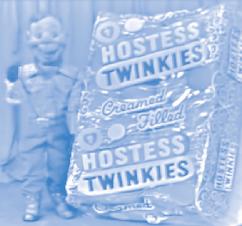
The Heyday of Hostess
(LEFT) Mom goes a bit nuts grabbing up all of the snack cakes in this screen capture from a 1970-era Hostess® commercial (who shops like this?). (INSERT) Howdy Doody shills for Hostess in a more subdued manner in this 1950-ish screen capture from the Howdy Doody Show [say howdy to Howdy in RetroFan #31]. Hostess © Hostess Brands, LLC. Howdy Doody Show © NBC Television.
involves a fair amount of business activity that’s not as interesting as snacks. It is important to note that the Ward family did get the ball of dough rolling. Hugh Ward’s son Robert moved to New York in the early 20th Century to found the Ward Bread Company. By 1911, two new Ward baking factories were opened; one in Brooklyn and the other in the Bronx. According to a large ad in The Brooklyn Daily Eagle (Nov. 7, 1911), the factories were the “brightest, whitest, cleanest places in all New York.” Food safety was on the public’s mind in those days and they were invited to visit the factories to see just how clean they were.
DOn’T EAT THAT! PART OnE
Upton Sinclair was a writer and activist who wrote the novel The Jungle dealing with, among other issues, unsanitary conditions in the meatpacking industry. First published in 1906, the book kicked up such a ruckus that it led President Theodore Roosevelt to press for the Pure Food and Drug Act (1906) and the Federal Meat Inspection Act (1907). This was beneficial to the general public, but Sinclair was not universally beloved. Time magazine once claimed that Upton Sinclair had “every gift except humor and silence.” Ouch.
FAMILY COnsUMPTIOn
Ward’s Bread Company advertised its product as 100% pure, and that was thanks to their amazing bread-making machinery which didn’t require a single human hand to touch the bread loaves along
RETROFAN June 2024 15
SCOTT SAAVEDRA’S SECRET SANCTUM
the way. The company would continue to stress purity and cleanliness in the its advertising. Salesmen wore white outfits and gloves and drove electric trucks (circa 1911) to make deliveries in a move away from unsanitary horsedrawn vehicles.
Ward’s Bread was soon purchased by James Ward’s great-grandson, who had started his own company, United Bakeries (there are other versions of this story; bread history is inconsistent). United had purchased some smaller bakeries as well, and then renamed the whole group the Continental Baking Company. One of the purchases was the Taggart Baking Company. Taggart’s signature product was Wonder Bread®, and it would have a big impact on the success of the company (once shoppers became more comfortable buying factory-made bread; it wasn’t an immediate hit). Continental quickly became America’s largest commercial bakery (though its reach then only extended to the Midwest). Continental Baking would be composed of two brands: Wonder for bread products and Hostess for baked goods.
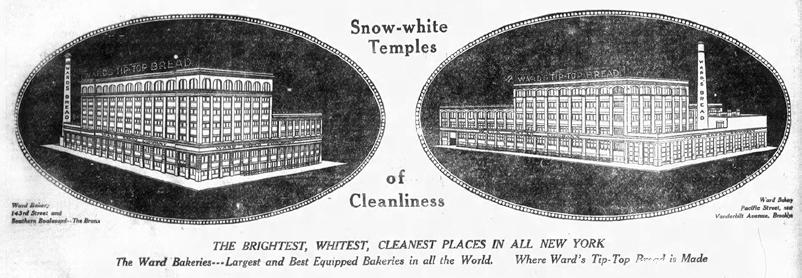
A Ward’s Bread ad detail from the Brooklyn Daily Eagle (Nov. 7, 1911) promoting food cleanlines, something of a new concern for the new century. Ward’s Bread was eventually bought up by United Bakeries, which became the Continental Baking Company, home of the Wonder Bread and Hostess brands. Courtesy of the Brooklyn Public Library.
There would be more changes ahead for Continental Baking, but at this stage of the company’s life the Hostess side had already produced what would lead to that brand’s first signature hit.
CUPCAKE s: FROM ELEGAnT DE sERT TO LUnCH BOX TREAT
The first Hostess baked success is, strictly speaking, not still with us, but it and the Hostess brand name arrived in 1919. Originally called the Hostess Chocolate Cup Cake, it did not have all of the features we now associate with the modern Hostess CupCake® There were two basic types: devil’s food cake with chocolate frosting and devil’s food cake with vanilla frosting. Early advertising for the cupcakes was more elegant in design and salesmanship than the more playful type of advertising seen by later generations. However, the “5¢ for two” price was an important part of the sales pitch, and that certainly appealed to shoppers of all types.
In the early days, these cupcakes were hand-frosted, a departure from the “no human hands” of the Wonder Bread side of the business. There were other hands on jobs, too. That of the “cake dumper” is fairly self-explanatory: you take baked cakes and dump them out of pans onto a table. You don’t have to be clever to do it. Fortunately for Continental, cake dumper D. R. “Doc” Rice was a competent young fellow when he joined the company in 1923. Rice worked his way up through the ranks and by the late Forties he was working in the experimental bakery at Continental’s headquarters in New York. It was there that Doc Rice would alter the company’s rather basic cupcake into the easily recognizable Hostess CupCake that we know today.
Partly, this was thanks to the Twinkie. The cream filling of Twinkies was originally inserted by hand with a special foot-
(RIGHT) Hostess magazine ad, circa the Twenties. Note the fancy Hostess boxes in the lower left of the grocery store counter. © Hostess Brands, LLC.
activated device that was easy to over-fill (and become a snack for the operator). Given a directive to improve cupcake sales, Doc Rice put Twinkie cream filling inside the cupcakes which, in 1947, had to be a “Why didn’t we do this sooner?” type moment. Long time coming or not, the addition was well received. A white line of frosting on top was the finishing touch. A straight white line of frosting. This quickly changed to the loopy line we know today. According to Doc Rice in a late-in-life interview (United Press International, May 10, 1989), sales for Hostess CupCakes with the

RETROFAN June 2024 16
s COTT s AAv EDRA’s s ECRET s A n CTUM
Let’s Kick Some Axis! Let’s Kick Some Axis!
The Stooges vs. Hitler? When iconic movie characters joined the fight
BY MARK v OGER
I’m a freak over the Sherlock Holmes movies starring Basil Rathbone. Don’t get me started! But the first one I ever saw—I must’a been in sixth grade—confused me a mite. It was called Sherlock Holmes in Washington (1943). In it, Holmes and Watson (Nigel Bruce) get on a plane and fly to the U.S. in search of a top secret microfilm stolen by German spies.
I was young, and more inclined toward comic books than classic literature. (Still am, actually.) I had yet to read my first Arthur Conan Doyle story. My vague picture of Sherlock Holmes was from London of long ago—horses and buggies, gas streetlights, men in top hats, women in bustles, fog.
So what was Sherlock Holmes doing hopping planes and fighting Nazis?
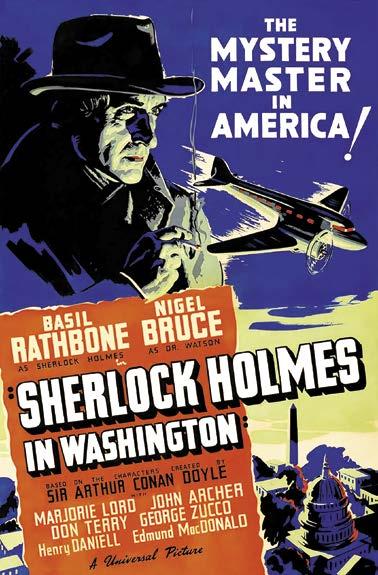
There’s a fascinating subgenre in the history of cinema: World War II Propaganda Disguised as Entertainment. Sherlock Holmes in Washington fell into that subgenre, if not a sub subgenre: Movies About Familiar Pop-Culture Characters Fighting the Axis Powers While the War was Ongoing.
In pursuing that microfilm, Holmes and Watson joined other iconic (and heretofore politically neutral) characters who heard the call such as Superman, Batman and Robin, Laurel and Hardy, the Invisible Man, the Three Stooges, the East Side Kids, Donald Duck, Bugs Bunny, and Popeye.
It sounds weird today, but there’s a practical explanation. Not long after the bombing of Pearl Harbor, the U.S. government established the Bureau of Motion Pictures (a division of the Office of War
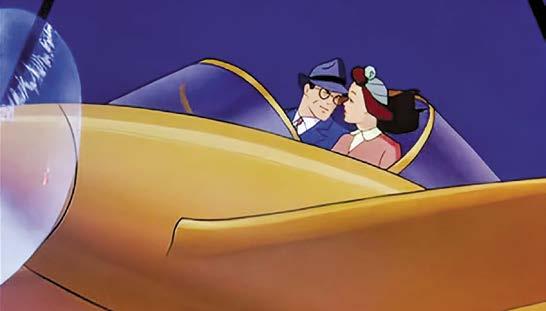
Holmes and Watson travel to America in search of a top secret microfilm in Sherlock Holmes in Washington. © Universal Pictures.
Information), which worked directly with film studios to encourage movies with powerful anti-Axis content.
Two important notes before we dive in. I will concentrate on films released during World War II, which lasted from 1939 until 1945, with America entering in 1941. (So the Marvel movie Captain America, which was set during World War II but released in 2012, doesn’t qualify. Nor do “peacetime draft”-era movies like 1941’s “Buck Privates” starring Abbott and Costello, which depict training but not war per se.)
There’s something about the fact that these films were produced in the midst of this historic global conflict that stirs the emotions in a more immediate way. Imagine: When Rathbone and Bruce walk past sandbags piled six feet high on a Universal backlot doubling for London, it was a Hollywood reenactment of something that was going on in real time.
Important Note #2: Keep in mind that on a good day, old-timey Hollywood movies reflect systemic racism (a subject for another column). But during the war, all bets were off. Anti-Japanese slurs were a fact of daily life. (A movie like Let’s Get Tough starring the East Side Kids was a twofer on the Racism-O-Meter. Pejoratives were thrown around disparaging Black as well as Japanese people.) I will only quote such dialogue when pertinent, but if you later track down and watch these films, well, caveat emptor.
OK? And now... on to victory!
COMIC BOOK HEROE s
The first depiction of Superman on film happened in cartoons. Five of the eight animated Superman shorts released by Famous Studios (following its takeover of Fleisher Studios) were war-themed. In the non-PC-compliantly titled Japoteurs (1942),
Clark and Lois hop a plane in an animated short with a title that could only have happened during World War II: Japoteurs (1942). © DC Comics.
RETROFAN June 2024 25
VOGER’S VAULT OF VINTAGE VARIETIES

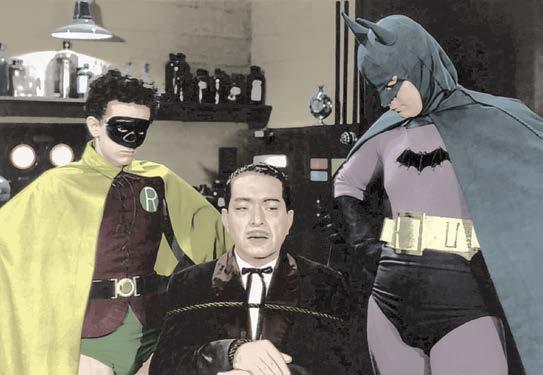
(LEFT) This caricature of a Japanese spy from the Superman short Japoteurs (1942) is mild compared to many of the offensive stereotypes that appeared in mainstream animation during the war years. (RIGHT) Robin (Douglas Croft) and Batman (Lewis Wilson) flank Dr. Daka (J. Carroll Naish, wearing prosthetic eyelids), ringleader of a Japanese spy ring, in the 1943 serial Batman. Colorized photo © Columbia Pictures. Superman, Batman, and Robin © DC Comics.
enemy agents commandeer an American invention, the “world’s largest bomber plane,” during its maiden voyage. In The Eleventh Hour (1942), Superman is in Japan (!) committing acts of sabotage. Lois Lane is abducted by the Japanese military, who hang posters putting Superman on notice: “Warning! One more act of sabotage and the American girl reporter will be executed at once!”
In Destruction Inc. (1942), Lois works undercover at a munitions plant suspected of enemy infiltration. In Jungle Drums (1943), Superman sinks a fleet of German submarines, while an extremely unhappy Adolf Hitler receives the news via radio. Secret Agent (1943) follows a beautiful undercover operative as she delivers an intelligence-rich dossier to Washington. [Editor’s note: See RetroFan #25 for columnist Will Murray’s deep dive into the Fleisher Superman cartoons.]
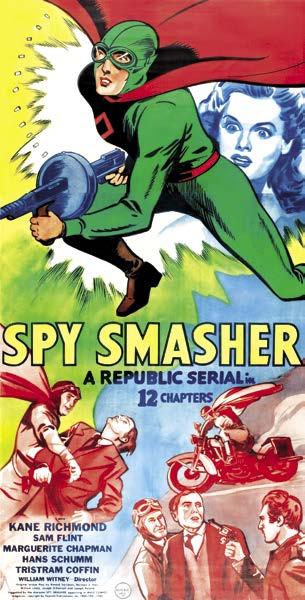
The serial Spy Smasher (1942) is based on the Fawcett Publications comic book hero. © Republic Pictures
Superman’s BFF Batman got in on the act too, this time in live-action. In Episode 1 of Batman and Robin’s first-ever depiction on film, Lambert Hillyer’s 15-chapter serial Batman (1943), the viewer is told: “They (Batman and Robin) represent American youth who love their country and are glad to fight for it.”
In the plot, Batman (Lewis Wilson) and Robin (Douglas Croft) pursue Dr. Daka (J. Carroll Naish), a Japanese spy based in
America. Twice-Oscar-nominated Naish was considered Hollywood’s chameleon who could play any “foreign” type. Of course, Naish is wearing those dreadful fake eyelids as Daka, and playing him as a broad caricature. It’s what the times demanded.
Daka’s headquarters is hidden in a section of Gotham City called Little Tokyo, which is now all but desolate. Quoth the narrator, “Since a wise government rounded up the shifty-eyed Japs”—don’t shoot the messenger—“it has become virtually a ghost street where only one business survives, eking out a precarious existence on the dimes of curiosity seekers.” That business is the Japanese Cave of Horrors, which is something like the Tunnel of Love but with tableaus of Japanese tyranny rather than ghosts and skeletons.
“I am Dr. Daka, humble servant of His Majesty Hirohito, heavenly ruler and prince of the Rising Sun,” Daka declares in his first line of dialogue. He can turn men into zombies, though plenty of American traitors work for him without the need for brain-snatching.
William Witney’s 12-chapter serial Spy Smasher (1942), based on Fawcett Publications’ comic book hero, stars Kane Richmond as the titular hero who matches wits with a Nazi saboteur (Hans Schumm). [Editor’s note: To read more about comic book-inspired movie serials, we enthusiastically recommend Christopher Irving’s book, Cliffhanger! (TwoMorrows, 2023).]
HORROR MOvIE s AnD WAR
One of America’s earliest World War II-themed movies was a low-budget horror film starring the screen’s Dracula, Bela Lugosi. In William Nigh’s Black Dragons (1942), Lugosi plays a plastic surgeon who alters the faces of Japanese spies to resemble American industrialists.
In Edwin L. Marin’s Invisible Agent (1942), Frank Griffin, Jr. (Jon Hall) is the grandson of the original Invisible Man. Two Axis oper-
RETROFAN June 2024 26 vOGER ’s vAULT OF v I n TAGE vARIETIE s
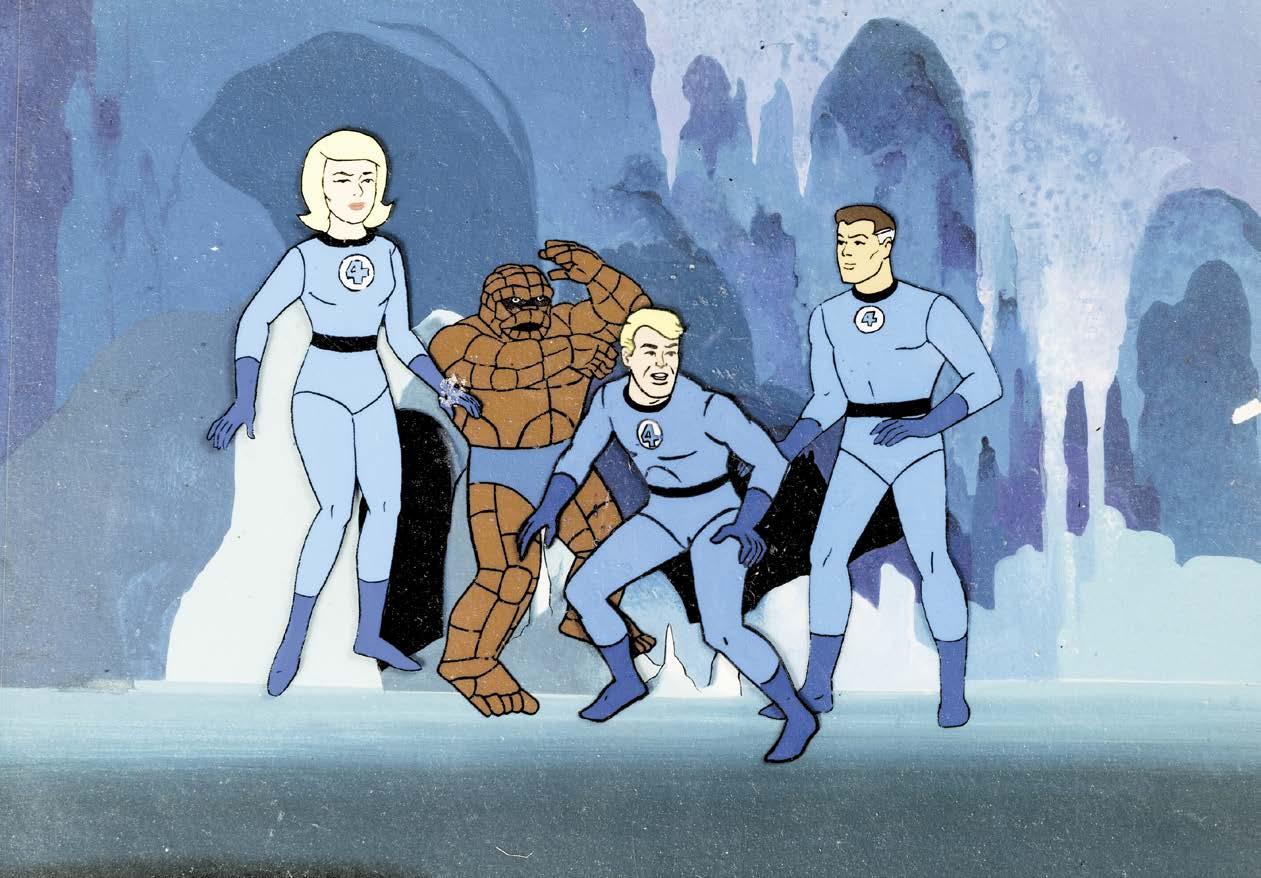
FANTASTIC FOUR and THE THING
BY A n DY MA n GEL s
Welcome back to Andy Mangels’ Retro Saturday Morning, your constant guide to the shows that thrilled us from yesteryear, exciting our imaginations and capturing our memories. Grab some milk and cereal, sit cross-legged leaning against the couch, and dig in to Retro Saturday Morning! This issue, we’re taking you Fabulous Fans on a dive into three Saturday morning shows that starred members of Marvel’s most Famous Family… The Fantastic Four!
Marvel Comics’ premiere super-team is the Fantastic Four, a cosmic ray–powered quartet who’ve thrilled fans since their debut in 1961. The “FF” (as fans know them) was created by Stan Lee, the head of Marvel, and Jack Kirby, one of the preeminent and most creative artists in the comics industry. Little did the pair know just how far their creations would take them. The Fantastic Four have spent a lot of time on the animated front, as well as in their own radio show, and in several feature films!
But not every member of the FF was treated the same on the air, with one member being snuffed out for a season, and another getting his own very weird spin-off series. Read on for the history of foursomes, robots, and other things…
MARvEL HEROE s COME TO TELE vIsIOn
Created by Stan Lee and Jack Kirby for Fantastic Four #1 (Nov. 1961), they were the world’s greatest dysfunctional—and most powerful—family. While traveling in scientist Reed Richards’ experimental rocketship, pilot Ben Grimm, Reed’s girlfriend Sue Storm, and her brother, Johnny Storm, were exposed to radioactive gamma rays which changed their molecular make-up and gave them remarkable powers. The now-stretchable Reed called himself Mr. Fantastic; the shy Sue became the disappearing Invisible Girl; the hot-headed Johnny shouted “Flame on!” to become the ball of fire named the Human Torch; and the bulky Ben got the raw end of the deal, becoming a super-strong orange rock-covered creature known as the Thing. Using their powers to aid mankind, the quartet known as the Fantastic Four would soon protect the planet from such cosmic threats as world-devouring Galactus, Latvertian armored dictator Doctor Doom, angry Atlantean monarch Sub-Mariner, and shape-changing alien invaders known as Skrulls. Along the way, the foursome become
(ABOVE) Cel set-up from Hanna-Barbera’s The Fantastic Four (1967). © Marvel. Courtesy of Heritage.
RETROFAN June 2024 33
ANDY MANGELS’ RETRO SATURDAY MORNING
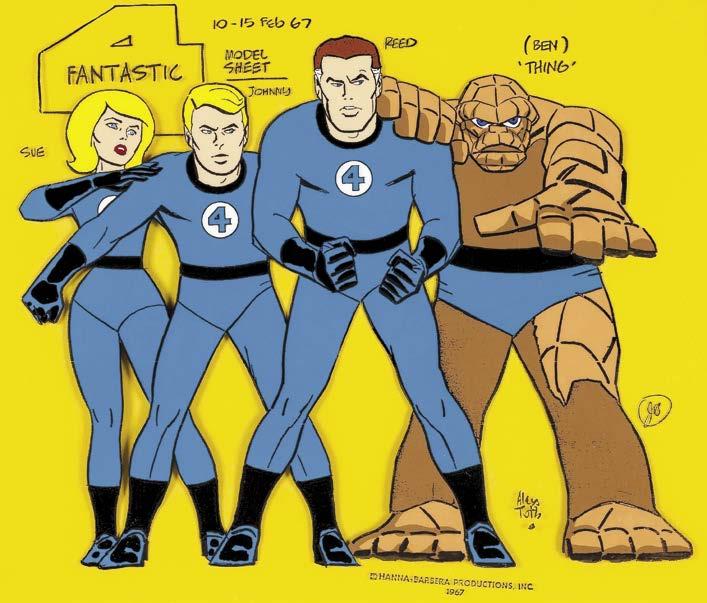
known by fans for their squabbling relationships as much as for their heroics.
Super-heroes were going through a revival in the early Sixties, but their popularity wasn’t noticed by networks until 1966. That same year, as the new Batman series became a campy live-action hit, a new cartoon studio called Filmation premiered The New Adventures of Superman on Saturday mornings [see RetroFan #25]. Also on deck weekday afternoons on syndicated stations was Grantray-Lawrence’s group of untried “tyro” heroes: the Marvel Super-Heroes series [see RetroFan #16].
Grantray-Lawrence was founded in 1954 by businessman Robert Lawrence and animators Grant Simmons and Ray Patterson. Lawrence bought the rights to most of the Marvel properties in the early Sixties: Captain America, Thor, Sub-Mariner, Iron Man, Hulk, X-Men, and Spider-Man According to Lawrence, The Fantastic Four was one property on which he didn’t have the option.
Animation “old-timers” Hanna-Barbera were looking for something new to dip their cels into, and super-heroes looked to be just the solution. Eyeing the high ratings of the Superman cartoon and the relative success of Marvel Super-Heroes, plus their own successes with Space Ghost and Dino Boy, Bill Hanna and Joe Barbara wanted their own Marvel series. And what they wanted was The Fantastic Four
In the crossover world of the Marvel Universe, Grantray-Lawrence was in a bind when they prepared to animate a Sub-Mariner story that strongly featured the
(LEFT) A colored cel featuring the Fantastic Four as rendered by Alex Toth. Toth was tasked with simplifying the more detailed comic book art of Fantastic Four co-creator Jack Kirby. (BELOW) Galactus character sheet by Toth. © Marvel. Courtesy of Heritage.
Fantastic Four. Because they couldn’t use the quartet, they substituted the comparatively new X-Men characters in their stead. They didn’t bother to change the designs for the Baxter Building, long the established FF headquarters, and Doctor Doom remained the villain. Bits and pieces of the stories from Fantastic Four issues now became X-Men adventures.
Hanna-Barbera had already started developing the Fantastic Four series by the time the Sub-Mariner episodes aired. Charles Nichols, a Disney director, was given the job of directing the episodes, while writers Jack Hanrahan and Phil Hahn all went directly to the comic book source material for their stories. “They were easy to write,” said Hanrahan. “We just went and took the stories directly from the comics. I would tear the comics in half and write up to the midpoint, and give the second half to Phil to write. Having worked in radio, I was used to the timing, and we could do a script in a day-and-a-half. After a while, I used the Dictaphone, because it was faster than typing.” He chuckled, adding, “Stan Lee thought we did a terrible job on the scripts. Compared to the later Fantastic Four cartoons, though, I guess we did okay.”

RETROFAN June 2024 34
A n DY MA n GEL s’ RETRO s ATURDAY MOR n I n G
THE FAnTA sTIC THREE… PLUs HERBIE?
Meanwhile, NBC’s Margaret Loesch was interested in bringing the quantum quartet back to the small screen on Saturday mornings, and it seemed that Hanna-Barbera thought the time was right for the series as well. They approached Jack Kirby, who was having problems with Marvel Comics management; he was excited at the chance to work in animation, and created large-scale presentation arts boards for the network.
The fly in Hanna-Barbera’s ointment was to come from Marvel itself. The company had formed a relationship with DePatieFreleng Enterprises, and wanted the FF show done by them (In 1980, DePatie-Freleng became Marvel Productions). Luckily, another compromise could be made. DePatie-Freleng had been developing an animated Godzilla cartoon with Jonny Quest creator Doug Wildey. Hanna-Barbera wanted Godzilla, and a swap was made with The Fantastic Four.
DePatie-Freleng brought on board Stan Lee and later FF comic writer Roy Thomas to develop the series, working with Kirby. Then they hit another snag in production. Johnny Storm was unavailable for the series, as Universal had optioned him for a one-hour live-action Human Torch show, in which he was to star as a race-car driver (the pilot was never shot, though a script was written). It’s also rumored that network executives were nervous that children might set themselves on fire if they saw the Torch flame on.
Who would take the Torch’s place on the team? The answer is revealed in the original introduction voice-over for the series: “It was the world’s strangest accident. While testing a new rocketship, our heroes were bombarded by mysterious cosmic rays from outer
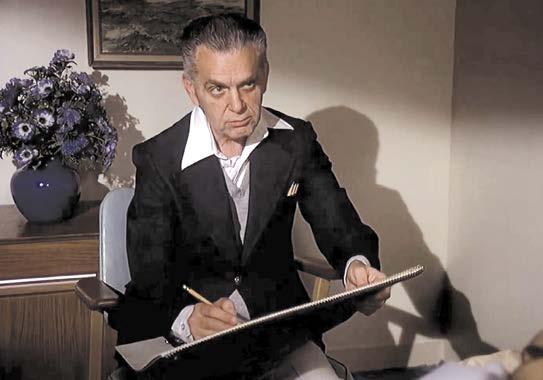
(ABOVE) Jack Kirby makes a cameo appearance on The Incredible Hulk TV show in 1978. (BELOW) Early Herbie the Robot design sketch by Kirby. Herbie was then known as “Z-Z-1-2-3.” Courtesy of Heritage.
space. Though they crash-landed safely, the strange and powerful rays had changed each one of them, transforming their leader, Reed Richards, into the plastic-skinned Mr. Fantastic, Sue Richards into the now-you-see-her/now-you-don’t Invisible Girl, and Ben Grimm into a mighty muscled powerhouse called the Thing. Now, together with ‘Herbie’ the robot, the newest member of the group,
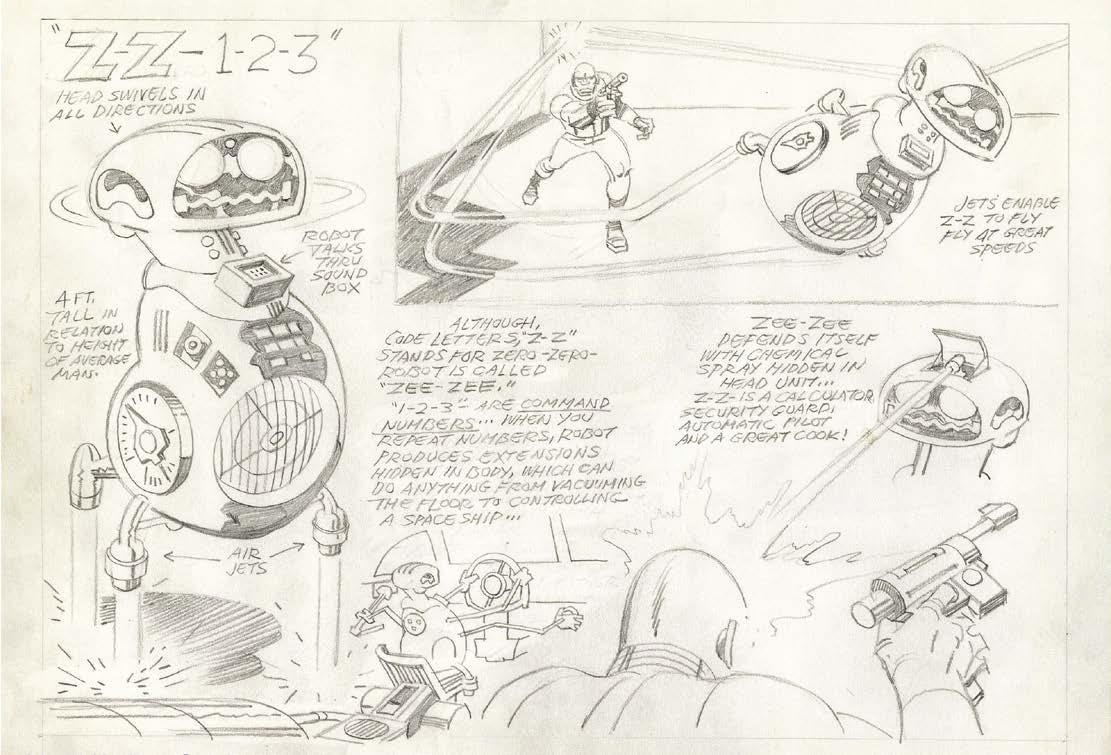
A n DY MA n GEL s’ RETRO s ATURDAY MOR n I n G RETROFAN June 2024 38
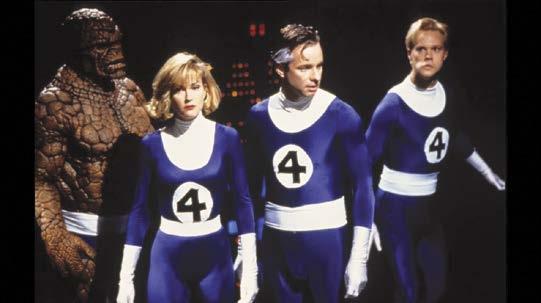
quartet, with Mr. Fantastic (Alex-Hyde White), the Invisible Woman (Rebecca Staab), the Human Torch (Jay Underwood) and the Thing (Carl Ciarfalio, voiced by Michael Bailey Smith) facing off against Doctor Doom (Joseph Culp) and the Jeweler (Ian Trigger). Although a charity premiere was announced for January 19, 1994, The Fantastic Four was scuttled before it could be released. It remains unreleased to this day, although bootleg recordings of it are easy to find, and a documentary about its making, Doomed, is available.
The Marvel Action Hour debuted in syndication in September 1994, courtesy of Marvel Films and New World Entertainment. The animated series consisted of a half-hour Fantastic Four segment combined with a half-hour Iron Man series. The first season of 13 episodes saw multi-part stories inspired by the comics, including the origin of the FF, and the introduction of the Silver Surfer, Galactus, and Doctor Doom. The second season featured drastically improved character designs and animation, as well as guest appearances by the Inhumans, Daredevil, Thor, Black Panther, Ghost Rider, the Hulk, and the Impossible Man. The series used lots of stunt voice-casting, including the voices of Dick Clark as himself,
plus Michael Dorn (Gorgon), Kathy Ireland (Crystal), Mark Hamill (Maximus), Ron Perlman (Wizard, Hulk), Richard Greico (Ghost Rider), and John Rhys-Davies (Thor).
The Marvel Action Hour was cancelled in fall 1996, but some of the FF characters reappeared in animated form. The Thing showed up in a 1996 first-season episode of UPN’s The Incredible Hulk. In 1997’s fifth season of Fox’s animated Spider-Man series, the Fantastic Four guest-starred in two episodes. And in 1998, Fox aired one season of
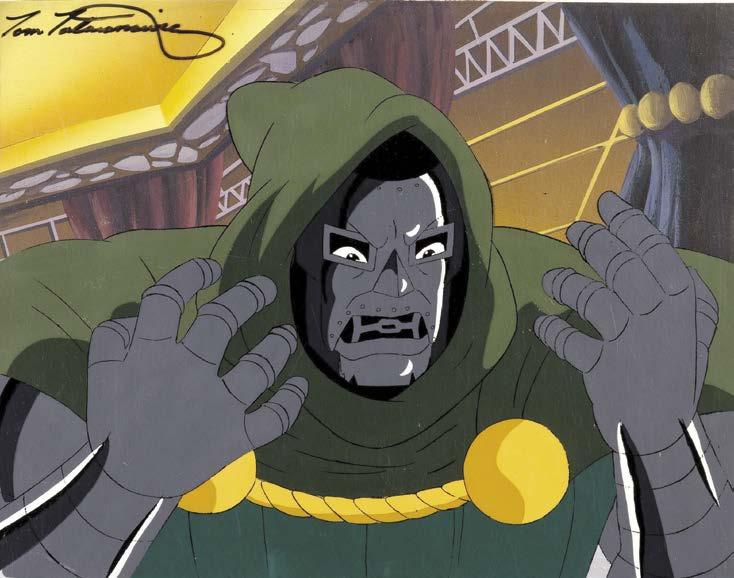

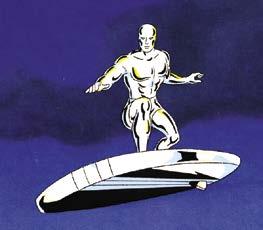
The Silver Surfer, which featured the title character and Galactus, and would have also featured the Fantastic Four if the in-production second season had not been cancelled.
Fantastic Four: World’s Greatest Heroes, a new half-hour series, debuted on Cartoon Network on September 2, 2006. This series was produced by the French animation company Moonscoop Group, and unlike previous shows, almost all of its stories were original. It featured the main quartet, as well as H.E.R.B.I.E. The show had 26 episodes, filmed in 16:9 widescreen, but Cartoon Network cropped it for broadcast. It seemed sabotaged from the start, as the network aired only
A n DY MA n GEL s’ RETRO s ATURDAY MOR n I n G RETROFAN June 2024 43
(LEFT) Publicity photo of the unreleashed 1994 movie, The Fantastic Four. © Marvel.
The Marvel Action Hour featured Dr. Doom (ABOVE) and other well-known villians. (BELOW) The Fantasti-Car in action. (INSET) The Silver Surfer. © Marvel. Courtesy of Heritage.
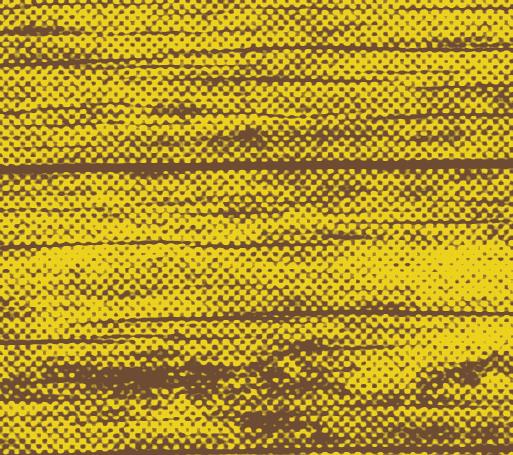
Too Many Westerns Too Many Westerns
BY WILL MURRAY
For the first 25 years of television broadcasting, one genre stood strong. The Western. After a slow start, Horse operas took over. Yet by the Eighties, they were all but extinct.
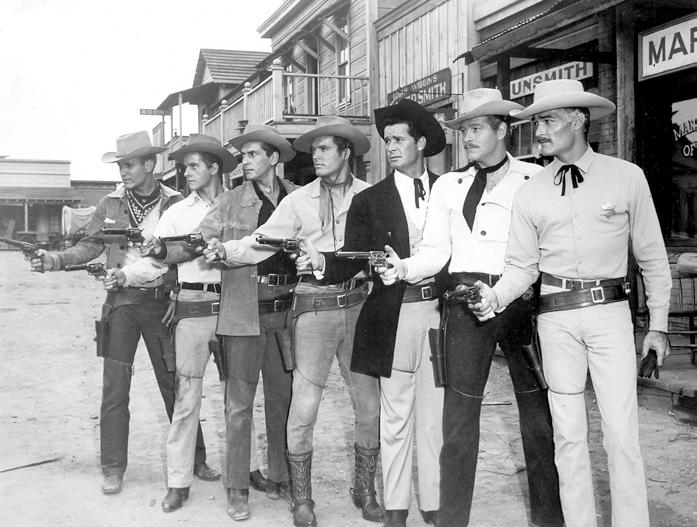
The pioneer TV Westerns were kiddie shows. The Lone Ranger drifted over from radio in 1949. The Cisco Kid and Hopalong Cassidy were among the first TV hits. Hopalong Cassidy started as recycled William Boyd movies cut into half-hour segments, then new episodes were shot. Gene Autry and Roy Rogers likewise transitioned from the silver to the small screen in 1951. [Editor’s note: Roy’s wife and screen partner, Dale Evans, was the subject of an article in RetroFan #29—still available at twomorrows.com.]
For years, television aimed its Westerns at small-fry Baby Boomers. Annie Oakley and Kit Carson were torn from history. Sky King was about a modern-day rancher who piloted his personal plane, the Songbird. All were syndicated. During TV’s formative Golden Age, networks didn’t take the genre seriously.
When Walt Disney televised Davy Crockett, King of the Wild Frontier in 1954-1955, it triggered a national merchandising craze. That year, 20th Century Fox entered television production with My Friend Flicka, a literal horse opera which was set on a Montana ranch. It replaced another drama built around Gene Autry’s horse,
(ABOVE) Welcome to the ABC-TV Corral in this 1959 publicity photograph teaming the network’s stars from their respective Warner Bros. Westerns. (LEFT TO RIGHT) Will Hutchins (Sugarfoot Brewster, Sugarfoot), Peter Brown (Johnny McKay, Lawman), Jack Kelly (Bart Maverick, Maverick), Ty Hardin (Bronco Laine, Bronco), James Garner (Bret Maverick, Maverick), Wayde Preston (Christopher Colt, Colt .45 ), and John Russell (Dan Troop, Lawman). ABC promotional photograph courtesy of Wikimedia Commons. Bronco, Cheyenne, Colt .45, Lawman, Maverick, Sugarfoot © Warner Bros. Television. Bat Masterson, Bonanza, Branded, The Virginian, Wagon Train © NBCUniversal. Gunsmoke, Have Gun—Will Travel © CBS Television Distribution. The Big Valley © ABC Television. Daniel Boone © 20th Century Productions. The Life and Legend of Wyatt Earp © Wyatt Earp Enterprises. Cowboy in Africa © Ivan Tors Productions.
The Adventures of Champion. My Friend Flicka, however, couldn’t compete against ABC’s The Adventures of Rin Tin Tin, a Western about a dog. Although based on a 1940 film, My Friend Flicka debuted four months after the similar Fury, which outlasted it by three years. All were aimed at moppets.
The sole exception was Death Valley Days, an anthology series hosted by “The Old Ranger.” After 15 years on radio, it switched to video in 1952 and ran 18 more.
Early on, the film industry looked down at television—until audiences switched to watching their home sets. Hollywood Westerns started maturing. Broken Arrow High Noon. Shane. Television executives noticed.
WARnER s GOE s WE sT
ABC lit the fuse on the prime-time Western craze in 1955 when the network hired Warner Bros. to produce an hour-long “wheel” series called Warner Brothers Presents. It was an anthology show consisting of three rotating features based on previous Warner Bros. films. Only one broke out into its own series: Cheyenne, starring Clint Walker. Walker had been a Las Vegas deputy sheriff until actor Van Johnson discovered him.
Cheyenne was TV’s first hour-long Western. Cheyenne Bodie was a giant of a man raised by the Cheyenne tribe after a different tribe murdered his parents. Warner Bros. wanted part-Cherokee James Garner in the role, but the actor could not be located in time. Garner’s time would soon come.
In an unusual move, ABC slotted The Life and Times of Wyatt Earp starring Hugh O’Brian in the half hour after Cheyenne. Ratings jumped.
That same year, Gunsmoke, a pioneer realistic Western program on radio, migrated to TV. It would run for two decades, expanding to an hour and eventually going to color. After dismissing actor Richard Boone as “too ugly” for the part of Marshal Matt Dillon, the producers went with James Arness. Boone’s time in the saddle was also fast approaching.
RETROFAN June 2024 47
20TH
PANOPTICON
WILL MURRAY’S
CENTURY
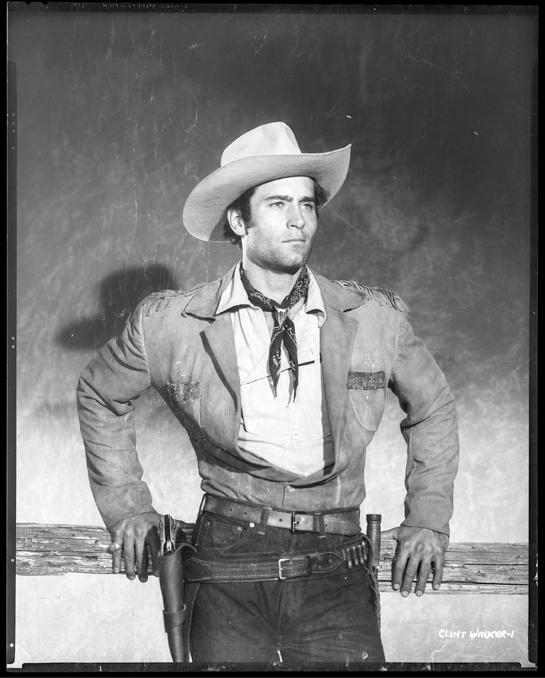
Gunsmoke tried to avoid the genre’s cliches. “We never do action for action’s sake,” insisted producer Norman Macdonnell. “For instance, we’ve never had a chase on Gunsmoke. We made a list of things that annoyed us in the regular Westerns. For instance, the devotion of the cowboy to his horse. That’s a lot of nonsense. The two things a cowboy loves best are his saddle and his hat. And cowboy speech isn’t full of things like ‘shucks’ and ‘side-winding varmint.’ What’s more, the frontier marshals made mistakes sometimes, and they weren’t always pure. The other week’s show is a typical example. Matt Dillon kills four guys and then is ashamed of himself.”
The era of the mature TV Western had arrived.
T v’s FIR sT MAJOR TRE nD
In 1956, ABC added Broken Arrow, based on the 1950 movie, as well as The Adventures of Jim Bowie. CBS introduced an anthology which would air backdoor pilots for potential Western programs, Dick Powell’s Zane Grey Theatre.

(LEFT) Human grizzly Clint Walker—who would’ve made a meaty Man of Steel had there been a Superman TV series in the Sixties—in a 1955 Warner Bros. publicity photo promoting his cowboy series, Cheyenne. Courtesy of Heritage.
NBC seemed reluctant to program oaters, but Tales of Wells Fargo started that year. Dale Robertson played Jim Hardie. It was a hit. More followed.
The hammer struck the cartridge primer in 1957. NBC launched Wagon Train, The Restless Gun, and The Californians. The network remained so gun-shy about Westerns that even though The Californians was set in the 1850s, they insisted it was not a Western. It was.
Wagon Train was inspired by John Ford’s Wagon Master, which had starred Ward Bond on the title role It was a vehicle to introduce name guest-stars and their stories every week, and it worked so well that even after Bond died in 1960, the show kept rolling along with replacement John McIntire. Through numerous cast changes, it lasted eight seasons.
CBS’s Rawhide was based on the same source as Howard Hawks’ classic film, Red River— Borden Chase’s novel, Chisholm Trail. The show tracked a cattle drive headed by trail boss Gil Favor. It ran successfully for eight years. For the final season, star Eric Fleming was let go and his sidekick, Clint Eastwood as Rowdy Yates, was promoted to lead.
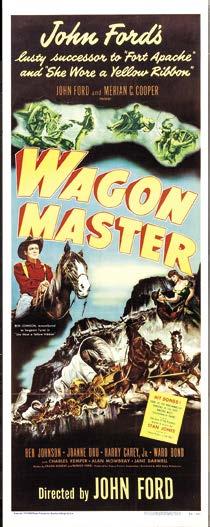
When Warner Bros. executive producer William T. Orr asked Roy Huggins to come up with a fresh Western series for ABC, the writer spent several days watching TV Westerns. He came away thinking that the only way he could do it was to produce a “good-natured assault on the whole Western formula.”
The hero Huggins envisioned was, “a lace-shirted overly cautious poker player dedicated to the pursuit of happiness, and the exploitation of the other guy’s ignorance of the laws of probability.”
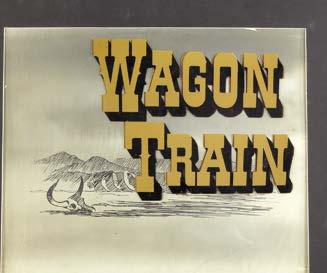
Hitch a ride on the Wagon Train! (LEFT) Director John Ford’s 1950 theatrical oater Wagon Master was an inspiration for (INSET) TV’s Wagon Train, whose opening title art is shown. (RIGHT) Star Ward Bond, who played Major Seth Adams, on the Wagon Train set with visiting Arkansas Senator John L. McClellan and actor Mickey Rooney in a publicity photo, circa 1959. All, courtesy of Heritage.


W ILL M URRAY ’s 20 TH C E n TURY PA n OPTICO n
RETROFAN June 2024 48


favorite TV horseman only owned one suit of clothes. It was just accepted.
Another one-suit hero was Daniel Boone, who wore buckskins and a coonskin cap. His series came into being when a TV producer wanted Fess Parker to revive his Davy Crockett portrayal for a weekly series. Walt Disney refused to release the rights, so Parker once again donned his familiar regalia—but as Daniel Boone, for six successful seasons.
The demand for new Wild West heroes meant shooting expensive pilots which might not ever air. A shortcut was discovered: Introduce a new character in an existing series as a way of testing his audience appeal.
Writer/director Sam Peckinpah recounted, “I did this one script for Gunsmoke that Charles Marquis Warren turned down— said it was a piece of crap! I knew it was one of the best things I’d written, so I took it back, and reworked it, and Dick Powell at Four Star bought it as the pilot for The Rifleman. I went along with the property as part of the bargain.”
Johnny Ringo, The Westerner, Black Saddle, and Trackdown also debuted on Dick Powell’s Zane Grey Theatre. Wanted: Dead or Alive, starring Steve McQueen, got its start on an episode of Robert Culp’s Trackdown Laredo spun off from The Virginian. And the short-lived Dakotas began as a episode of Cheyenne.
Michael Ansara, who previously starred as Cochise on Broken Arrow, played a different Apache in two episodes of The Rifleman, Marshal Sam Buckhart, the hero of Law of the Plainsman.
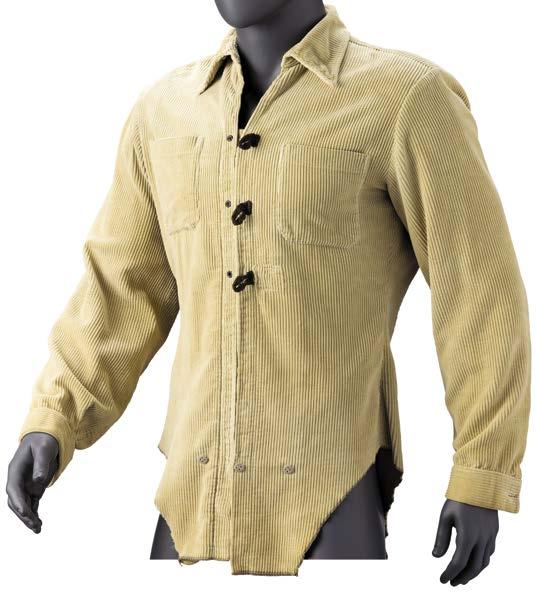
(LEFT) Chuck Connors as Lucas McCain in an autographed ABC-TV publicity photo promoting The Rifleman. (If only the horse had also signed this…) (RIGHT) Connors’ custommade corduroy tunic, his primary Rifleman costume. Both, courtesy of Heritage.
Western programs so dominated the airwaves it was tough to sell anything else. Writers Sam Rolfe and Herb Meadows concocted a modern adventure series about a soldier of fortune who would fly to any trouble spot on earth for a price. They pitched the idea to CBS’s Hunt Stromberg.
Recalled Rolfe, “So, Hunt immediately said, ‘Make this a Western and you’ve got a deal.’ We, of course, said, ‘Sure.’ Then, we walked out in the corridor, looked at each other and said, ‘How the hell do we turn this into a Western?’”
The result was Have Gun – Will Travel, starring Richard Boone as the sophisticated gunman-for-hire, Paladin.
Actor Nick Adams asked Andrew J. Fenady to create a TV show for him. “We didn’t want a Western,” remembered Adams, “but sponsors won’t buy anything good until you put a horse on it.” He found himself astride one as an ex-Confederate soldier in The Rebel
Every type and time period of the Old West was represented on TV, from Riverboat— a “Midwestern”—to Hotel De Paree, whose gun-hero wore a gimmick hat that blinded opponents
TOO MAnY WE sTERns?
In 1959, audiences rebelled. This was the turning point. Variety reported: “The Western fever has subsided. For the first time since 1956, the new entries failed to take off like a house on fire.”
Only one new Western was renewed: NBC’s Laramie, which ran to 1963, the year Cheyenne was unhorsed.

W ILL M URRAY ’s 20 TH C E n TURY PA n OPTICO n
RETROFAN June 2024 52
Hot Wheels The Early Years
BY MIKE PIGOTT
The Mattel company was founded in 1945 by husband-and-wife team Elliot and Ruth Handler and their partner Harold “Matt” Matson, the brand name formed from a combination of “Matt” and part of “Elliot.” The partners originally produced wooden picture frames out of a garage in Los Angeles, but found that making doll’s house furniture from wooden offcuts was more profitable. Moving into the toy industry, Mattel had great success producing miniature musical instruments. In 1959, Ruth Handler introduced the Barbie doll [if you missed our Barbie history a few issues back in RetroFan #30, you can still order a copy at twomorrows.com! —ed.], the first teenage fashion doll, which was copied from a German “den toy” based on a popular racy comic strip.
During the Sixties, Mattel had great success with dolls, but less luck with boys’ toys. The company made a wide range of realistic toy guns, but these were becoming less popular due to concerns over violence. As toy guns used diecast components, Elliot Handler suggested that the machinery used for these could be repurposed to manufacture miniature cars. Diecast cars had become very popular in the post-war years, with the U.K. being the biggest producer. Brands such as Dinky, Corgi, and Lone Star sold well in both Europe and America, but the market leader was the Matchbox series of affordable, pocket-sized vehicles made by Lesney of London. The Matchbox range had won the American Boys’ Toy of the Year Award twice in the Sixties, and Handler was frustrated to see his grandchildren playing
Early Hot Wheels
International catalog from 1967. Hot Wheels © Mattel. Unless otherwise noted, all product images shown with this article are courtesy of Mike Pigott.
with these imported toys when his firm was one of the largest toy companies in the U.S.A. Colleagues at Mattel were against entering the diecast market, believing there was too much competition and that it would be too difficult to break the stranglehold Matchbox had on the market.
However, Handler believed that a new diecast line could be successful if Mattel offered something different. His team looked at all the diecast cars on the market and found three problems: most cars had thick axles and didn’t roll freely; there were few American cars produced, with many being unfamiliar foreign marques; and that few featured much in the way of play value, being more like collectibles than toys—this was certainly the case for ranges like Matchbox Models of Yesteryear and Corgi Classics, which were clearly aimed at adult collectors.
E nTER: HOT WHEEL s
In 1966, Handler assembled a team to develop his model car range. The design team tackled the problem of rolling wheels; instead of
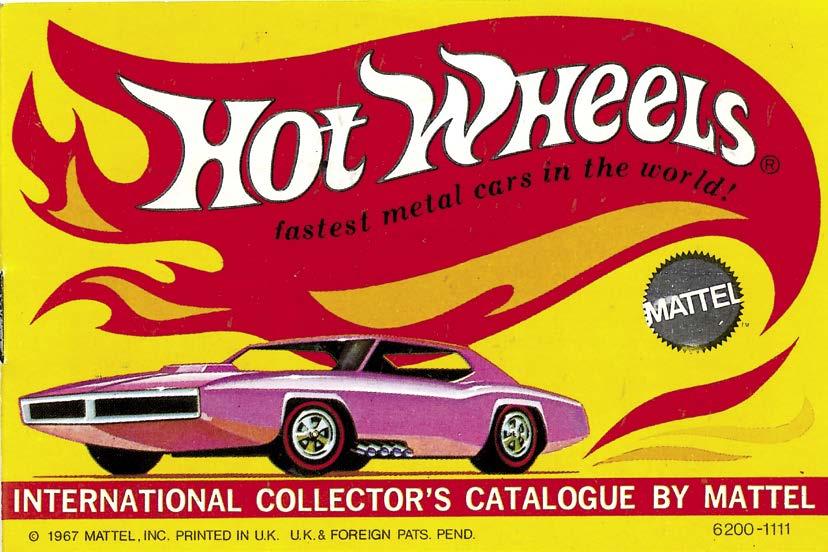
RETRO TOYS RETROFAN June 2024 58

using metal rods for axles, fine wire intended for toy guitar strings was used. The thick, two-piece wheels were made from a lowfriction polymer plastic that allowed them to roll very fast. Initially the axles were U-shaped to provide torsion-bar suspension, but when these proved unreliable, straight axles were used, with a plastic strip riveted on top. The wheels were imitation mags with chrome hubs and the fashionable red-stripe tires.
Mattel advertised for auto industry stylists to design the range of cars. Harry Bradley, who had worked for General Motors and Chrysler, became the first Hot Wheels designer. Accustomed to developing real cars, he struggled to design toys until Handler suggested that Bradley’s own car was what he was looking for. This vehicle—a souped-up Chevy El Camino with an exposed engine, side exhausts, and mag wheels—became the basis for Custom Fleetside. Bradley then designed most of the other early Hot Wheels cars, which were “California styled,” mildly customized American sports cars, plus some custom-built show cars. To give extra play value, several had opening hoods or other working parts.
A Hot Wheels catalog page reveals all of the new toys’ features.
The series was given a name: Hot Wheels, because they were HOT cars with fast WHEELS. They were packaged on die-cut blister cards and included a collector button.
TRACK s
After the cars, the most important element was the track system and accessories. Initially one of the design team bought some extruded plastic strips intended for building insulation, and used this to test how far the cars could run. The others thought this was a great idea, and began developing the Hot Wheels track. Inspired by daredevil stunt-driving shows, features like loops and jump-ramps were designed, with manual and battery-powered boosters added later.
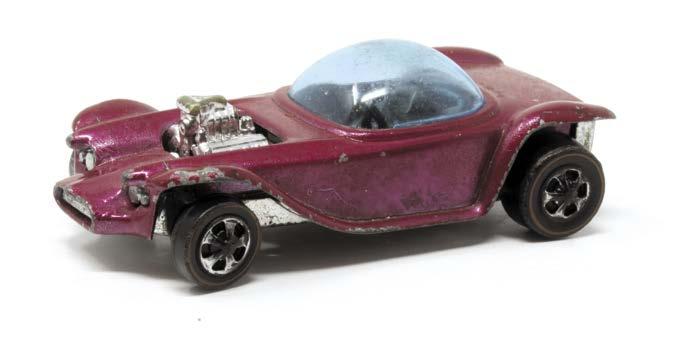
THE MODEL s
Sixteen models were released in 1968. Nine of these were based on customstyle American muscle cars: Custom Mustang, Custom Corvette, Custom Barracuda, Custom Cougar, Custom Firebird, Custom Fleetside, Custom Eldorado, Custom Camaro, and Custom T-Bird. In addition there was one European car, Custom Volkswagen; plus Hot Heap, a Model T–based hot rod, and Ford J-Car, a GT racing car. The other four items were custom show rods, including the bubble-topped Beatnik Bandit, based on a car designed by Ed “Big Daddy” Roth [see RetroFan #10 for Big Daddy’s story, you dig?—ed.]. Python and Silhouette were show cars created by Bill Cushenberry, and Deora was a heavily customized Dodge pick-up built by the Alexander Brothers—the Hot Wheels model had a pair of surfboards clipped on the back.
In contrast with the model cars produced by other companies, which were often in dull, unimaginative colors, Mattel chose to give its cars a shiny, eye-catching finish like the candy colors used on custom cars. Called “Spectraflame,” it wasn’t actually metallic paint; instead the car bodies were given a shiny zinc plating, which was then sprayed with a tinted clear lacquer, giving a metallic look.
(ABOVE) The Beatnik Bandit, an iconic Hot Wheels from the original 16 models. (RIGHT) Tracks set Hot Wheels apart from other metal cars, as seen in this 1968 promotional material.


RETROFAN June 2024 59
BY PETER BO s CH
How to describe my infatuation with Modesty Blaise? Well, let’s start with the basics. I’m a writer and I thrill to great writing from others. And Modesty Blaise is either the best-written comic strip you’ve never heard of or the best-written strip you know about and love. There is no in-between. Of all the comic strips that have ever been, none to me equals the sheer storytelling skill by Peter O’Donnell in Modesty Blaise. (His other fans have included Neil Gaiman, Walter Simonson, Dick Giordano, and Quentin Tarantino.) And then there are the novels! Fans of the novels are quite easy to tell. Their copies of the paperbacks are ones that any author would be proud to see…multiple creases in the spines from being read attentively, and well-worn covers from carrying the book in their pocket wherever they went.
In total, there were 95 newspaper strip adventures (over 10,000 strips), 11 novels (plus two short story collections), a separate comic-illustrated story, a screenplay, and a DC Comics graphic novel. And every one was written by Peter O’Donnell. Modesty Blaise was his creation and he wrote every strip and book of those 38 years.
BUT WHO WA s MODE sTY BLAIsE?
Book reviewers called her an adventuress, the female answer to James Bond (though that is the most incorrect way to think of her, and something O’Donnell took umbrage with). Modesty Blaise was probably the most capable woman in action fiction. Cathy Gale, Emma Peel, Pussy Galore, and Honey West could come at her en masse and Modesty would put them down easily.
She started out life as a young child in a Nazi prison camp in Greece, not knowing her name or even how old she was. When the woman whose hand had held hers ceased to breathe, the child escaped and wandered alone through Turkey and Persia, begging or
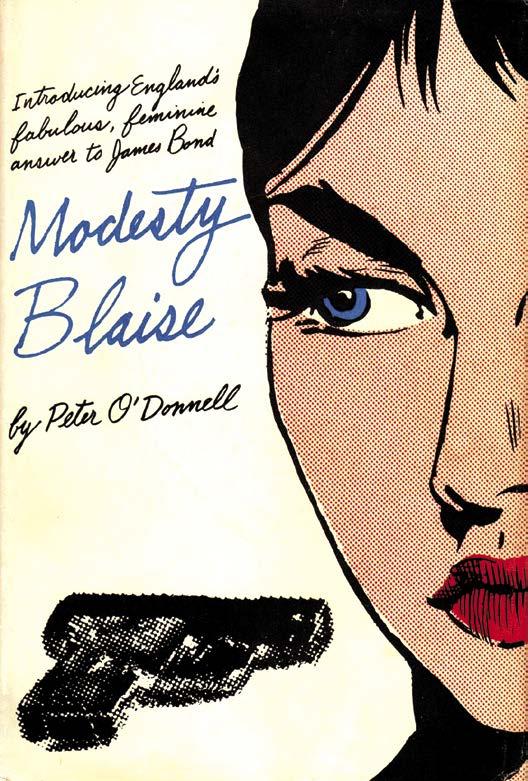
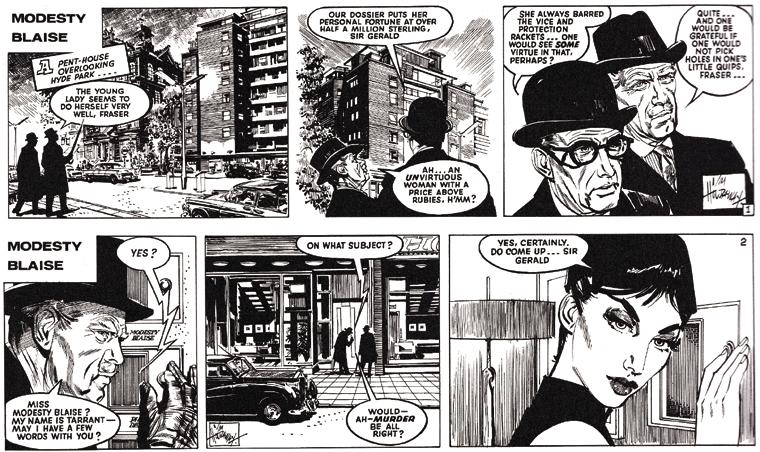
(ABOVE) First Modesty Blaise novel by Peter O’Donnell, with Jim Holdaway dust jacket (Doubleday, 1965). (LEFT) The first two Modesty Blaise strips, May 13 and May 14, 1963, in the Evening Standard. Introduction of Sir Gerald Tarrant, his assistant Jack Fraser, and the woman herself, Modesty Blaise. Art by Jim Holdaway. All images, scripts, and novel writings of Modesty Blaise and other characters from the Modesty Blaise comic strip and books are © Modesty Blaise Ltd. All images accompanying this article are courtesy of the author.
RETRO COMIC STRIPS
RETROFAN June 2024 63
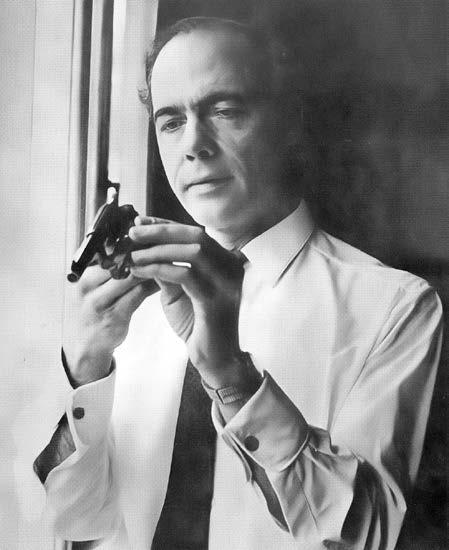
East, and the western desert. One of his assignments was in northern Persia (now Iran), camped out there with fellow soldiers, watching for any advance of the German army. They saw a constant line of refugees pass by, and then one day she appeared. A little girl, no more than 12 years old, by herself, a bundle on her head that likely contained her only belongings. O’Donnell suggested offering some of their rations and tea to her. However, when they approached her with a mess tin of food, she backed away. They moved back a comfortable distance. She ate the meal, then used sand to wash away the grease and cleaned the plate. She bowed to them in thanks. They then gave her several tins of stew, which she accepted, bowed, and went away. O’Donnell recalled she walked like a princess, without fear.
That memory stayed with Peter O’Donnell and it served as the inspiration for Modesty Blaise’s background two decades later.
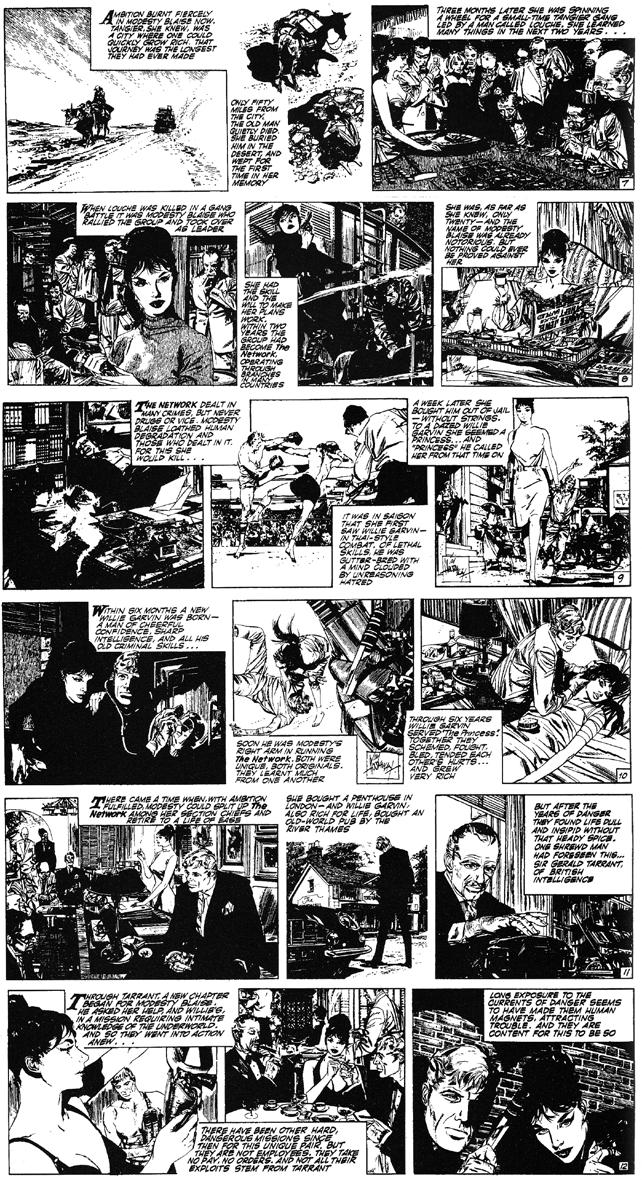

After getting out of the Service in 1946, he went back to writing for various publications. His first writing of an actual newspaper strip was doing a fill-in on the Daily Mirror ’s Belinda when the regular writer was ill. The Mirror liked his work and asked him to take over Garth, an adventure strip about a time traveler. He also created Tug Transom in 1954 for the Daily Sketch. And, in 1956, he was asked to take over the writing of Romeo Brown, a strip about a goofy private detective, when its creator received a better offer to work for a rival newspaper. Jim
RETROFAN June 2024 65
Willie sums up perfectly his feelings about Modesty. Original art by Jim Holdaway, from the collection of the author.
RETRO C OMIC s TRIP s
(ABOVE) From the text accompanying this photo, “Peter O’Donnell examining a Colt .32 revolver—one of the two guns Modesty Blaise favors for business.” Photo by Fiona Adams.
How the Became America’s Tastiest Mascot SAN DIEGO CHICKEN
BY s COTT s HAW!
“A pet chicken for a radio station? How bizarre.”
–The KGB Chicken
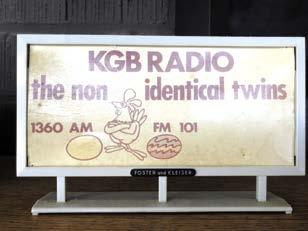
Growing up in San Diego, I was introduced to radio by my parents, who constantly listened to one of the local stations, KCBQ—which played the Top Forty hits—in the mid-Fifties on their cars and in our kitchen in the morning.
One day, when I was five, I discovered an inflated balloon in our backyard. At first, I thought it had drifted over from our neighbors, who were always having birthdays because they had six kids. But as I examined it, there was a tag attached to the balloon... from KCBQ! It was a promotional gimmick for a free .45 RPM record to anyone who found any of the hundreds of balloons that KCBQ’s helicopter dropped over San Diego. My choice was the Cadets’ outrageously funny classic, “Stranded in the Jungle” (1957), a tune I’d still love to adapt into an animated short. As a pre-teen, I’d follow different deejays on different San Diego AM rock stations. My favorite was Lee “Baby” Simms, one of the outrageous influences on the creation of WKRP in Cincinnati ’s “John Caravella,” a.k.a. “Dr. Johnny Fever.” While in college, I’d hang out at the local radio stations to draw cartoons outside the booth to entertain the nighttime deejays. That’s when I realized how similar cartoonists are to disc jockeys: we both work alone in a room trying to be funny to a faceless audience.

(ABOVE) Radio station KGB’s San Diego Chicken energizing the crowd at a sport event. (INSET) Model billboard of KGB’s “chicken” ads. Unless otherwise noted, all images accompanying this article are courtesy of Scott Shaw!
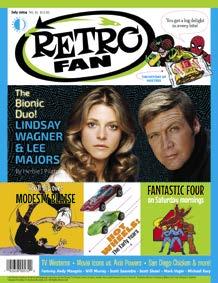
RETROFAN #33
Meet the Bionic Duo, LEE MAJORS and LINDSAY WAGNER! Plus: Hot Wheels: The Early Years, Fantastic Four cartoons, Modesty Blaise, Hostess snacks, TV Westerns, Movie Icons vs. the Axis Powers, the San Diego Chicken, and more! Featuring columns by ANDY MANGELS, WILL MURRAY, SCOTT SAAVEDRA, SCOTT SHAW, and MARK VOGER. Edited by MICHAEL EURY
(84-page FULL-COLOR magazine) $10.95 (Digital Edition) $4.99
By 1972, I was living in Orange County, north of San Diego, but its theme parks, car and wax museums, and alligator farms weren’t for me. I still commuted to San Diego on weekends to see friends and work in plans for San Diego Comic-Con, but finally dropped out of college—I’ve never been asked if I had a degree for a single job as a cartoonist until the digital age—and
https://twomorrows.com/index.php?main_page=product_info&cPath=98_152&products_id=1773
moved back home to start drawing underground comix while day-working at book stores and libraries. There, I first saw a wide billboard that introduced a new character that would eventually wind up as San Diego’s unofficial ambassador as well as a nationally recognized comedic performer. It was a giant chicken, who looked like it had just smoked a joint or two with Sid and Marty Krofft. Suitably, it was the new mascot for San Diego’s AM/ FM station KGB.
With my background, how could I not have been drawn to “ the KGB Chicken”?
BRIAn nARELLE
The character was created by Brian Narelle, a creative fellow with a fascinating career that includes a major role in the live-action sci-fi comedy Dark Star (1974), an animation character designer for Sesame Street, and the supervising animator on George Lucas’ feature film Twice Upon a Time (1983). Now living in the Wine Country of Sonoma County, Brian is currently a cartooning teacher at the Charles Schulz Museum.
Here’s how Brian Narelle recalled his essential role in the hatching of the chicken…
RETROFAN June 2024 72
THE ODDBALL WORLD OF SCOTT SHAW!
ENJOYED
CLICK THE LINK TO ORDER THIS ISSUE IN PRINT OR DIGITAL FORMAT!
IF YOU
THIS PREVIEW,
RetroFan is no longer sold in Barnes & Noble stores.
miss
today!
info&cPath=61&products_id=1375
But it’s still available in independent bookstores, comic book shops, by mail order and subscription, and digitally! Don’t
an issue— subscribe
https://twomorrows.com/index.php?main_page=product_

 By Herbie J Pilato
By Herbie J Pilato



















 BY HERBIE J PILATO
BY HERBIE J PILATO












































